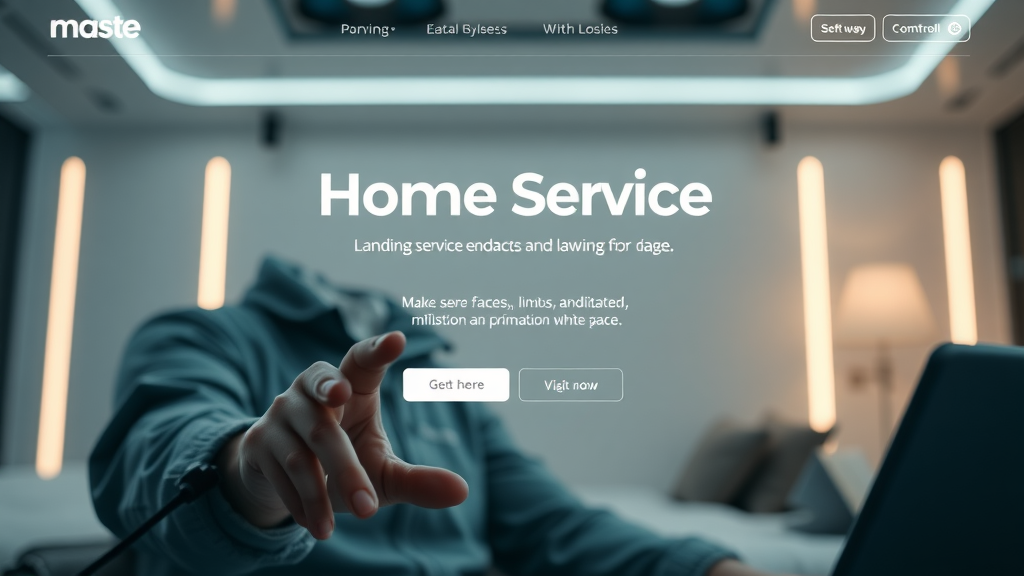Did you know that 61% of consumers will not return to a website they found difficult to use? While a flashy design might catch your eye, it’s not the secret to climbing Google’s search rankings—especially for home service businesses. If your home service website isn’t bringing in leads, you might be focusing on the wrong elements. In this easy-to-follow guide, you’ll uncover exactly what Google values—so you can beat your competitors, attract more potential customers, and stop wasting time (and money) on expensive, unnecessary web design features.
- What Google actually looks for in a home service website
- Essential website elements to build trust and drive conversions
- How to structure service pages for top search rankings
- Common web design mistakes and how to avoid them
Unlocking Google Rankings: Surprising Truths Beyond Website Design
"61% of consumers will not return to a website they found difficult to use—Google knows this too."

A Paradigm Shift: Why Site Design Isn’t Everything for Home Services
It’s easy to assume that a modern, visually stunning web design is all you need for digital success, but Google’s algorithms are far more practical. While an attractive site can make a good first impression, it’s not the main driver behind high rankings for home service websites. In fact, user experience, content quality, and technical functionality play a much bigger role. What sets top-ranking service websites apart isn’t surface-level style—it’s how effectively the site solves a potential customer’s problem and answers their questions.
Focusing solely on web design can result in neglecting core elements like easy navigation, clear calls-to-action, and targeted service information. Google cares more about how visitors interact with the site: Do they find what they need quickly? Can they contact your business without frustration? Is your content better than your competitors’? By understanding this, home service providers can optimize for both humans and search engines without blowing the budget on unnecessary fancy features.
- The difference between attractive web design and what actually ranks
- User experience as a core Google ranking factor
- Why content and credibility outweigh a good web design
Key Factors Google Looks for on a Home Service Website

1. Clear and Specific Service Pages: Content Over Clutter
A home service website with generic, vague service descriptions just won’t make the cut for Google’s rankings. Each of your service pages should offer detailed, unique information about a specific service—think "HVAC Repair" or "Gutter Cleaning"—instead of lumping everything on one web page. This level of clarity helps Google recognize what your business actually does, making it easier to match your site with searchers’ needs. It also shows users that you are a specialist, not just another generic service provider.
Beyond word count, well-structured web page layouts give each service a dedicated space. This means breaking up text with helpful headings, bullet points, and project photos—enhancing both readability and search relevance. Don’t forget important keywords related to each specific service on every separate page. This organization boosts your site’s authority and signals to Google that you’re a true expert in your domain.
- Comprehensive and distinct service pages for each offering
- Proper site design with structured web page layouts
- Effective use of relevant keywords on all service pages
| Factor | Why It Matters | What to Improve |
|---|---|---|
| Unique Service Pages | Helps Google understand your business | Create a page for every service |
| Contact Information | Builds trust and local SEO value | Make contact details visible on every web page |
| Internal Linking | Improves user and crawler navigation | Link related services and landing pages |
2. Accurate Contact Information Across All Web Pages

Google pays close attention to the consistency and visibility of your contact information on every web page—not just the home page. Having a clear phone number, contact form, and your business address makes it easier for Google to connect your website to your Google Business Profile and local search queries. This builds trust not only with potential customers, but also with Google’s algorithm, helping you appear more credible and legitimate.
Every service page should feature easy-to-find contact details, ensuring that visitors never have to hunt for a way to reach you. This is especially important for mobile visitors, who expect to tap and connect instantly. Consistency across your site—using the same spelling, format, and layout—cements your authority in local results and creates a smoother user experience.
- Prominent contact form or phone number on every service page
- Consistent address and contact information for local search rankings
3. Fast-Loading and Mobile-Friendly Web Design
- Speed as a decisive Google ranking factor
- Mobile-first site design strategies
- Avoiding heavy stock photos and unnecessary elements

Site speed and mobile-friendliness can make or break your home service website’s Google rankings. As more users browse on smartphones, Google now prioritizes sites that load quickly and look great on any device. Bloated graphics and unnecessarily complicated design elements only serve to slow things down. Instead, prioritize crisp code, optimized images, and intuitive navigation for a streamlined digital experience.
Simple layouts free of clutter, with minimal use of large stock photos, help ensure your web page loads within two seconds on mobile devices. This is essential for reducing bounce rates and increasing conversion rate. Mobile-first design means your site adapts gracefully to various screen sizes, keeping contact forms, phone numbers, and core information always accessible. Google actively penalizes slow, outdated sites, so invest in smart speed optimization and usability.
4. Trust-Building Elements: Social Proof and Customer Reviews
One thing Google and customers both value is social proof . Displaying real, positive customer reviews—and making them visible directly on your landing pages and service pages —signals legitimacy and reliability. Verified Google reviews, testimonials, and visual elements like "before and after" galleries quickly reassure new visitors. Clean white space around these elements keeps things approachable and emphasizes the words that matter most.
Showcasing trust signals goes beyond a few sentences at the bottom of the web page. Consider adding star ratings, badges, or even embedded video testimonials for higher engagement. This approach is proven to build trust with both your target audience and with Google’s algorithm. When social proof is genuine and upfront, conversion rates increase and so does your ranking potential.
- Featuring social proof on landing pages and service pages
- Showcasing verified Google reviews and testimonials
- Use of clean white space for enhanced readability

5. Strong Internal Linking and Clear Navigation
- Site design that supports easy flow between service pages and main landing page
- Organized navigation for better web development outcomes
- Boosting conversion rate through seamless user journeys
For Google to fully understand your business website, it needs a logical structure and strong internal links. Well-organized site design not only helps users jump from a landing page to related service pages, but also makes it easier for Google to crawl and index your entire site. Every click should lead users closer to getting the help they need, not down a confusing rabbit hole.
Intuitive menus, breadcrumbs, and inline links pointing to relevant pages enhance both user experience and search rankings. Simple, consistent navigation reduces confusion and supports higher engagement, especially on mobile. This organization improves conversion rate by connecting the dots for potential customers and encouraging them to request service without frustration.
Structuring Home Service Pages for Google: Practical Tips

Optimizing Service Pages and Landing Pages: Essential Components
- Content quality and relevance over flashy web design
- Using a consistent color palette to strengthen brand identity
- Highlighting benefits and project photos instead of generic stock photo
When creating winning service pages or landing pages for a home service website, skip the bells and whistles and zone in on content. Prioritize clear, well-written descriptions that answer visitors’ most pressing questions, backed by real project photos to prove your credibility. Choose a color palette and branding elements that reinforce your business’s identity, but always keep legibility and accessibility in the forefront by ensuring enough white space.
Avoid over-reliance on generic stock photo images, instead showcase actual work from your portfolio. Break the web page into easily digestible sections—features, benefits, process steps, and a strong value proposition—so users know exactly why they should choose you. Google wants to direct searchers to service pages that offer meaningful, comprehensive information and a seamless path to conversion.

Including Conversion-Focused Elements: Contact Forms and CTAs
- Strategic placement of contact forms on key service pages
- Optimizing the layout for higher conversion rates
No matter how detailed your content is, every service page and landing page should make it easy for a visitor to reach out. Place clean, prominent contact forms on each main service page—preferably above the fold and repeated at the bottom of longer pages. Use clear, compelling call-to-action (CTA) buttons, such as “Request a Quote” or “Schedule a Visit,” to drive the next step and boost your website’s conversion rate.
Simplify what you ask for: name, contact details, and details about the required service are usually enough. Remove unnecessary fields that can reduce form submissions. Make sure your CTAs stand out visually, using color schemes and placement that draws attention but fits the overall web design. These elements, when implemented correctly, can turn a passive site visitor into an actual booking or lead with ease.

The Role of Good Web Design - Balancing Functionality and Aesthetics
- Simple, functional web page layouts trump excessive design
- Leveraging white space to improve comprehension and trust
- Ensuring accessibility and legibility across devices
While design isn’t the only thing that matters, good web design does have a supporting role—it just needs to serve a purpose. White space (empty areas around your content) improves comprehension, keeps your brand looking professional, and prevents visitor overwhelm. Simple layouts direct visitors straight to what they need, supporting both credibility and usability.
Strike a balance: Don’t neglect visual elements altogether, but never add animation, color schemes, or graphics that make your site harder to use. Accessibility is non-negotiable—ensure your text is legible and buttons are easy to tap, regardless of device or viewing conditions. The best performing home service websites blend strong content, easy navigation, and just enough visual polish to support—not distract—from the user’s journey.
What Google Looks for in a Website
Comprehensive Content Structure

Google loves websites with a clear, logical structure—the kind that guides users and search bots alike. A comprehensive content structure means every page has a clear purpose, and related topics are grouped logically. Home service businesses should structure their business website so the home page acts as a gateway to specific landing pages and deeply informative service pages, with internal links supporting the journey.
This doesn’t just help Google index your content, it also drives users towards the desired action—whether that’s a call, booking, or quote request. Grouping sections by service area, project type, or frequently asked questions gives both users and Google a reason to stay and explore, improving your chances of higher rankings and more conversions.
Technical SEO and Web Development Best Practices
Beneath every high-performing home service website is a solid technical foundation, thanks to smart web development . Fast-loading pages, secure HTTPS, compressed images (not bloated stock photo files), and mobile-responsiveness all send strong signals to Google that your site deserves to rank well. Don’t skip essential on-page SEO tasks: relevant title tags, meta descriptions, and schema markup for contact information and reviews.
Regular audits of your web pages for broken links or outdated plugins are crucial. By aligning your technical approach with Google’s standards, you protect your site from penalties and ensure your content gets seen by your target audience. The best home service websites make web development decisions that keep both search engines and potential customers in mind.
What to Include on a Services Page
Detailed Descriptions and Targeted Keywords
Every high-ranking service page starts with crystal-clear explanations of what you offer, who it’s for, and the problems you solve. Use natural, targeted keywords that match what your ideal customer would actually search. Go beyond the basics—share step-by-step breakdowns, FAQs, and even honest pricing ranges if possible. Google rewards in-depth content that matches searcher intent.
Structure your service page with clear headings, sub-sections, and brief, punchy paragraphs. This not only improves readability but also helps with how Google crawls your web pages. Authenticity wins: speak in simple, conversational language that reassures and informs. Aim to answer the big question: “Is this service the right fit for me?”
Social Proof and Testimonials
Don’t underestimate the impact of adding social proof . Verified testimonials, star ratings, or photos of past projects (instead of only stock photo imagery) reassure your visitors, humanize your business, and push them closer to a decision. Place this social proof near the top or alongside your call-to-action, so it’s always visible when a user is considering reaching out or booking your service.
You can boost credibility by linking out to your Google Business reviews or embedding third-party rating widgets. Remember, for Google, trust-building elements are as important as keyword optimization—so feature real customer voices front and center. This works to build trust with potential customers right where it matters most.
How to Make a Google Sites Website Look Good
Emphasize Function Over Form with Good Web Design
Google Sites and other simple builders can work for home service providers as long as you focus on function, not just form. Choose a basic website design template that offers clean navigation, easy listing of your service pages, and high visibility for contact information. Avoid heavy backgrounds or confusing color schemes; instead, stick to a consistent color palette with plenty of white space. This ensures your site is easy for anyone to use.
Keep it simple. Make sure your phone number and contact form are easy to find on every page. Use authentic project photos instead of generic stock photo fillers. Above all, make sure your web pages load quickly on mobile. The easier your site is to use and read, the more Google will reward it in search results.
What Does a Well-Designed Website Look Like?
Core Pillars of Effective Web Design for Service Providers
- Balanced color palette and purposeful white space
- Easy-to-find and consistent contact information
- Blending high conversion landing page tactics with sound site design

A well-designed home service website isn’t just about appearance—it’s about combining aesthetics with strong conversion performance. The most effective sites use a simple, harmonious color palette, leave room for ideas to breathe through white space, and strategically highlight navigation and calls-to-action. They emphasize easy, consistent access to contact information and use real project galleries, not just a stock photo here and there.
Combine what works in high-conversion landing page tactics: prominent CTAs, service highlights, social proof, and logical, step-by-step navigation. A blend of intentional visual elements and practical site design keeps users engaged and gives Google plenty of reasons to rank you higher than your competitors.
Avoiding Common Mistakes in Home Service Website Design
- Overuse of stock photos instead of authentic project galleries
- Cluttered layouts that hinder navigation and conversion rate
- Weak or hidden social proof elements
Watch out for the most frequent website design pitfalls in this industry. Using generic or non-representative stock photos can make your brand feel less credible and won’t help you build trust with visitors or Google. Overly complex or cluttered layouts create frustration, driving up your bounce rate and sinking your search performance. Don’t hide reviews or testimonials where no one will see them—they should be front and center.
Focus on giving each piece of information its own space, sticking to a clear structure, and keeping your contact details bold and accessible. Putting actual completed projects on display will do far more for your reputation (and SEO) than any flashy visual trick or expensive web development add-on.
The Do’s and Don’ts: List of What Google Looks for on a Home Service Website
- DO create separate, keyword-rich service pages for every main offering.
- DO make your contact information easy to find and consistent.
- DO use customer testimonials and other forms of social proof.
- DO ensure your web page loads fast and is mobile-friendly.
- DO maintain a simple, intuitive site design with clear navigation.
- DON’T rely solely on fancy web design features to boost SEO.
- DON’T clutter pages with excessive graphics or large stock photos.
- DON’T ignore the importance of conversion-focused landing pages.
Frequently Asked Questions About What Google Looks for on a Home Service Website
-
Does Google care about color palettes and modern web design?
Color palettes should support brand clarity and user experience, but Google ranks sites higher for structure, content, and usability over looks. -
How important are social media links on my service pages?
Social media provides additional trust signals and can assist conversion rate, but on-page SEO fundamentals come first. -
Can I use stock photos on my service pages?
Stock photos are acceptable if relevant, but authentic images of your projects build more trust with both users and search engines. -
What is the ideal conversion rate for a home service landing page?
While it varies by industry, a good web page conversion rate for home services typically falls between 5-10%.
Transform Your Home Service Website for Top Google Rankings
Take action: Focus on content structure, trust signals, site speed, and easy navigation—not fancy design—to unlock better Google rankings and get more leads from your home service website. Start optimizing today!
To enhance your understanding of what Google prioritizes in home service websites, consider exploring the following resources:
- “SEO for Home Services: 10 Tips from Home Services SEO Experts” ( sachsmarketinggroup.com )
This article offers practical advice on optimizing your website for search engines, emphasizing the importance of local citations, showcasing certifications, and displaying before-and-after project photos to build credibility and improve local search visibility.
- “The Complete Guide to Local SEO for Home Service Businesses” ( truebluecollar.com )
This comprehensive guide delves into managing online reviews and reputation, highlighting how positive customer feedback influences local SEO rankings and builds trust with potential clients.
By integrating the strategies outlined in these resources, you can effectively align your home service website with Google’s ranking factors, enhancing both user experience and search engine visibility.
 Add Row
Add Row  Add
Add 



 Add Row
Add Row  Add
Add 
Write A Comment